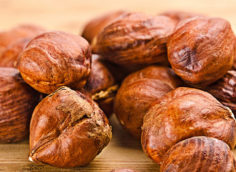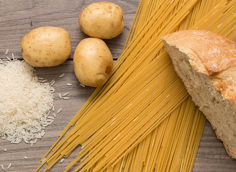Massive Eating Revolutions
In Part 1, Mr. Anderson, I presented a systematic way of gradually increasing your energy intake using the "Seven Habits of Highly Effective Nutritional Programs" and the Science Link System of Nutritional Individualization. This process involved simply calculating your approximate energy needs to give you a goal to shoot for. You figure out how much energy you're currently eating and then adjust your meal plan to follow the Seven Habits without changing this energy intake.
Next, at your current energy intake, you should assess your body weight and body composition after two weeks. Finally, you should begin to increase or decrease your daily energy intake by 250kcal based on how your body is changing over the two week time intervals.
While this system should make complete sense, I realize I did leave out a few critical details. So, this week it's time to pull out the studies and answer some remaining questions you might have.
In Massive Eating Part II, I presented a feeding strategy that centered on the idea of eating protein with every meal. With protein as the staple of each feeding, meals would be rounded out with either carbohydrate or fat, but not large amounts of both.
In other words, I suggested eating a few meals per day that contain protein and carbohydrate (P+C) and a few meals that contain protein and fat (P+F). While I never suggested entirely eliminating F from P+C meals and C from P+F meals, I noted that this plan is designed to minimize the occasions you combine lots of C and lots of F in the same meal.
There are two premises behind this strategy. The first is fat burning. High protein meals increase the thermic effect of feeding, increase fat oxidation, and reduce carbohydrate oxidation when compared to high carb meals. This effect persists during chronic high protein diets. (10, 21, 22)
Even when a considerable amount of carbohydrate energy is included in such a diet (or in a single meal), it appears that protein-induced increases in the hormone glucagon can increase lipolysis (fat mobilization from adipose tissue) and subsequent fat oxidation (fat burning) during rest and exercise. (22) While the hormone insulin is known to decrease lipolysis and fat oxidation, glucagon may, in some situations, provide a more powerful stimulus, promoting increased lipolysis and fat oxidation even while insulin is kicking around. (6-8, 24) Interesting, huh?
Therefore, by eating a higher protein diet, even with an appreciable amount of carbohydrate, you'll end up burning more total fat while sparing muscle glycogen and providing amino acids for recovery and growth. Sound like a good strategy for simultaneous muscle gain and fat loss? You bet it is!
The second premise behind the combinations discussed above is insulin management. Since insulin is both a storage hormone (pushing nutrients into tissues like muscle, adipose and liver) and an anti-breakdown hormone (preventing the release of macromolecules from liver, muscle and adipose tissue), a chronic elevation in blood insulin – especially in the presence of carbohydrate and fat – will probably sabotage your attempts to get big while still looking good sans sweatshirt. (1, 3-5, 7, 13)
So by eating protein with every meal and avoiding high concentrations of insulin, glucose, and fat in the blood, it appears that body composition can be managed more easily. This isn't to say you won't gain any fat. Instead, it's suggesting that fat gain may be reduced. Combine this body fat management strategy with a high-energy intake and what do you get? Well, simultaneous muscle growth and fat loss might not be an urban legend after all!
At this point, it's time to add a few caveats to the original plan; upgrades, if you will. In the original articles I suggested minimizing C intake during P+F meals and minimizing F intake with P+C meals as an easy way to avoid the dreaded high glucose, insulin, and fat cocktail. However, this isn't the only way to avoid this combo. Here are a few "rule breakers" which allow you to eat some types of C with your P+F meals:
- Veggies, despite being carbohydrate, won't destroy your well-planned P+F meals. Vegetables are very low on the glycemic scale and won't promote a large insulin response. In fact, rather than just being "okay" during P+F meals, I suggest that they're essential as they're rich in micronutrients and can balance out the net acidity inherent in a high protein meal. (20, 25) For this reason, veggies should be ingested just about every meal.
- Very low glycemic carbohydrates also can be ingested during P+F meals. Of course, I've written before about some low GI foods that actually provoke a big insulin response, so not all low GI foods are acceptable when combined with P+F meals. (11) As a result, I typically reserve veggies, fruits, and beans as "Massive Eating Approved" during P+F meals.
However, even with these foods, don't go overboard. The insulin response to a meal is dependent on both the type and the amount of total carbohydrate. (18) Therefore some veggies and one piece of fruit might be occasionally okay during a P+F meal, but lots of veggies and three apples? Not so okay.
The next step toward improving the Massive Eating meal plan is increasing your awareness of the concept of nutrient timing. Up until this point, you've been made aware of the Seven Habits, gradually increasing energy intake, using an outcome-based strategy for further increases, and avoiding meals high in C+P+F.
However, none of this information tells you when to eat your P+C and P+F meals. By staggering these meals appropriately, you can take advantage of what we know about how the body metabolizes and stores nutrients during specific times of the day, especially the post-exercise period.
For starters, the immediate post-exercise period is marked by a dramatic increase in insulin sensitivity, glucose tolerance, and glycogenic activity; this means that muscle glycogen re-synthesis rates are dramatically elevated during the immediate post-exercise period. (5, 17) If nutrition is delayed however, glycogen re-synthesis rates are reduced. (12, 19) Therefore, carbs during the immediate post-exercise period are a must. This should come as no surprise.
The addition of protein during the post-workout period shouldn't be a shocker either. Increases in post-exercise protein intake can provide amino acids for increased protein synthesis, muscle repair, and muscle recovery. (3, 14, 23, 26) Also, since protein ingestion increases metabolic rate (with most of this increase coming from fat oxidation), the addition of protein to the post-workout meals may lead to losses in fat mass while the body is simultaneously increasing muscle mass. (15, 16, 23)
That's right, even in the face of a high post-exercise carbohydrate intake, the combination of protein and carbohydrate may promote increases in glycogen and protein synthesis (muscle anabolism) while, at the same time, promoting fat loss (fat catabolism). Since carbs are most likely to be stored and fat most likely to be oxidized after exercise anyway, the ingestion of a few P+C meals during this time can even further accelerate the muscle building anabolic processes while also accelerating the fat burning process. (2, 9)
From this discussion it should be pretty clear that a couple of P+C meals should be ingested during the few hours after your training session (whenever that might be). Not only will you get a superior anabolic response, but you'll probably continue losing fat as well. According to new data from my lab, it may even be possible to promote full muscle glycogen recovery during the six hours after exercise. Therefore I recommend eating most of your daily carbs when your body's carbohydrate storage capacity is highest – during the few hours (4-6 hours) post-exercise.
That's post-exercise. During the remainder of the day, when insulin and glucose tolerance are lower and more carbohydrates are likely to be converted to lipids in the liver, sent to adipose tissue, or promote a larger (lipolysis decreasing) insulin response, P+F meals would be ingested. This further assists in the management of insulin and body composition while continuing to spare carbohydrate.
With your daily P+F meals, a good balance of fats should be ingested, with each type of dietary fat making up about one-third of your total daily intake (33% saturated fats, 33% monounsaturated fats, 33% polyunsaturated fats with 50% omega 3's and 50% omega 6's).
Using nutrient timing in this way will provide you a unique and effective strategy for consuming an abundant amount of micronutrient dense, glycogen-replenishing carbohydrates; metabolism altering, hormone-stimulating fats; and muscle building, amino acid rich proteins, while simultaneously preventing excessive hyperinsulinemia and excessive fat gain. All while you pack on slabs of freaky muscle mass!
At this point, one component of the plan remains unaddressed – what macronutrients to include when it's time to schedule your bi-weekly energy increase. Revisiting the idea that you'll slowly be increasing energy intake every two weeks or so, it's important to clarify both which meals should contain the extra energy (calories) and which macronutrients should make up this energy.
While personal insulin sensitivity and personal preferences can be important in deciding this, the system I use is relatively straightforward in most cases.
- Step 1: Continue with Seven Habits.
- Step 2: Increase carb energy (+250kcal) in workout and post-workout drinks.
- Step 3: Increase carb energy (+250kcal) in first post-workout food meal.
- Step 4: Add carb energy (+250kcal) in breakfast on workout days.
- Step 5: Add fat energy (+250kcal) spread out through the day.
- Step 6: Repeat Step 5.
This system leads to a net increase of 1250kcal over ten weeks. Now, if you're starting with a very low energy diet, you may need to double up these numbers. And, of course, this is just a rough sketch of how I approach most clients. Since my approach is outcome-based, bi-weekly feedback gives me a better opportunity to fine-tune these recommendations.
What have we learned so far?
- Adopt the Seven Habits without changing total energy intake.
- Meals shouldn't contain high amounts of C and F simultaneously.
- P+C meals should come during exercise and the post-exercise period.
- Most of your daily C intake should be focused in and around the workout.
- The remainder of your meals should be comprised of P+F.
- Veggies, beans, and low GI fruits can be added to P+F meals in moderation.
- Energy intake should be increased gradually rather than suddenly.
- Every two weeks, you should assess your progress and alter energy intake if necessary.
- Individual differences mean subtle modifications must be made for some people.
Using guidelines one through eight, I generated a sample meal plan. This plan represents a 4,000kcal diet and should be adapted in an outcome-based manner.
Meal 1 (P+F)
- 2 chicken sausage links
- organic spinach
- 1 cup organic carrots
- 2 tablespoons apple cider vinegar
- 1 tablespoon flax oil
Meal 2 (P+F)
- 12 egg whites
- 1 slice regular cheese
- chopped fresh veggies
- 1 tablespoon flaxseed oil
- 2 fish oil capsules
- quarter cup walnuts
Meal 3 (P+F)
- 1 scoop of protein powder like Metabolic Drive® Protein
- 4 fish oil capsules
- 1 cup full fat organic yogurt
Meal 4 (P+F)
- 1 cup of 8-12 bean mix
- 4oz lean beef
- organic spinach
- 1 cup organic carrots
- 2 tablespoons apple cider vinegar
Meal 5: During Workout (P+C)
- 1 serving of a recovery drink like Mag-10®
Meal 6: Immediately After Workout (P+C)
- 1 serving of recovery drink like Mag-10®
Meal 7: One Hour Post Workout (P+C)
- 1 cup fat free organic yogurt
- 1 scoop protein powder like Metabolic Drive® Protein
- 2 cups frozen berries
- 2.5 cups cereal
Meal 8 (P+C)
- 4 oz extra lean beef
- organic spinach
- 1 cup organic carrots
- 2 tablespoons apple cider vinegar
- 1 piece fruit
- 2 slices unprocessed grain bread
This plan assumes an evening training session. If you train in the mornings, simply ingest meal one first, meals five through eight immediately after training, and meals two through four at the end of the day.
- Commander Lock: Not everyone believes in what you do, Morpheus.
- Morpheus: My beliefs do not require them to.
A quick note about this system and then I'll close. Over the last three years, the original Massive Eating plan has been published in its entirety on at least 30 websites and in several languages. This information, combined with the thousands of testimonials I've received from readers and clients, tends to make me think that the plan works.
Of course, over the last three years, several critics have also emerged and have attempted to debunk the logic behind the plan. For the critics, I say this... I understand that the original Massive Eating plan isn't perfect (no human attempt at manipulating physiology is). The body is complex terrain and until we have it completely figured out (ha, ha) there will be no perfect meal plan. In the meantime, people need an internally consistent system that helps them achieve their goals. Massive Eating Reloaded does this.
Critics, criticize all you want, but until you come up with a better system, save your pseudo-intellectual wanking for those more interested in online debates than pushing heavy weights.
And this line closes another chapter on the Massive Eating plan. Massive Eating Reloaded is a unique plan in that it puts all the power in your own hands. There are no mysteries or magic tricks, only patience, discipline, consistency and progress. If you're interested in gaining lean mass without all the extra fat of a typical "bulking" regimen, you owe it to yourself to give this plan a try. It's my most effective to date.
- Annuzzi G et al. Increased insulin-stimulated glucose uptake by exercised human muscles one day after prolonged physical exercise. Eur J Clin Invest. 1991 Feb;21(1):6-12. PubMed.
- Bielinski R et al. Energy metabolism during the postexercise recovery in man. Am J Clin Nutr. 1985 Jul;42(1):69-82. PubMed.
- Biolo G et al. Physiologic hyperinsulinemia stimulates protein synthesis and enhances transport of selected amino acids in human skeletal muscle. J Clin Invest. 1995 Feb;95(2):811-9. PubMed.
- Biolo G et al. Insulin action on muscle protein kinetics and amino acid transport during recovery after resistance exercise. Diabetes. 1999 May;48(5):949-57. PubMed.
- Borghouts LB et al. Exercise and insulin sensitivity: a review. Int J Sports Med. 2000 Jan;21(1):1-12. PubMed.
- Calbet JAL et al. Plasma glucagon and insulin responses depend on the rate of appearance of amino acids after ingestion of different protein solutions in humans. J Nutr. 2002 Aug;132(8):2174-82. PubMed.
- Campbell PJ et al. Regulation of free fatty acid metabolism by insulin in humans: role of lipolysis and reesterification. Am J Physiol. 1992 Dec;263(6):E1063-9. PubMed.
- Carlson MG et al. Regulation of free fatty acid metabolism by glucagon. J Clin Endocrinol Metab. 1993 Jul;77(1):11-5. PubMed.
- Folch N et al. Metabolic response to a large starch meal after rest and exercise: comparison between men and women. Eur J Clin Nutr. 2003 Sep;57(9):1107-15. PubMed.
- Forslund AH et al. Effect of protein intake and physical activity on 24-h pattern and rate of macronutrient utilization. Am J Physiol. 1999 May;276(5):E964-76. PubMed.
- Holt SH et al. An insulin index of foods: the insulin demand generated by 1000-kJ portions of common foods. Am J Clin Nutr. 1997 Nov;66(5):1264-76. PubMed.
- Ivy JL et al. Muscle glycogen synthesis after exercise: effect of time of carbohydrate ingestion. J Appl Physiol (1985). 1988 Apr;64(4):1480-5. PubMed.
- Kiens B et al. Effects of insulin and exercise on muscle lipoprotein lipase activity in man and its relation to insulin action. J Clin Invest. 1989 Oct;84(4):1124-9. PubMed.
- Layman DK. Role of leucine in protein metabolism during exercise and recovery. Can J Appl Physiol. 2002 Dec;27(6):646-63. PubMed.
- Layman DK et al. A reduced ratio of dietary carbohydrate to protein improves body composition and blood lipid profiles during weight loss in adult women. J Nutr. 2003 Feb;133(2):411-7. PubMed.
- Layman DK et al. Increased dietary protein modifies glucose and insulin homeostasis in adult women during weight loss. J Nutr. 2003 Feb;133(2):405-10. PubMed.
- Price TB et al. Human muscle glycogen resynthesis after exercise: insulin-dependent and -independent phases. J Appl Physiol (1985). 1994 Jan;76(1):104-11. PubMed.
- Rasmussen O. Dose-dependency of the glycemic response to starch-rich meals in non-insulin-dependent diabetic subjects: studies with varying amounts of white rice. Metabolism. 1993 Feb;42:214-217.
- Reed MJ et al. Muscle glycogen storage postexercise: effect of mode of carbohydrate administration. J Appl Physiol (1985). 1989 Feb;66(2):720-6. PubMed.
- Remer T et al. Potential renal acid load of foods and its influence on urine pH. J Am Diet Assoc. 1995 Jul;95(7):791-7. PubMed.
- Robinson SM et al. Protein turnover and thermogenesis in response to high-protein and high-carbohydrate feeding in men. Am J Clin Nutr. 1990 Jul;52(1):72-80. PubMed.
- Rowlands DS et al. Effect of high-fat, high-carbohydrate, and high-protein meals on metabolism and performance during endurance cycling. Int J Sport Nutr Exerc Metab. 2002 Sep;12(3):318-35. PubMed.
- Roy BD et al. The influence of post-exercise macronutrient intake on energy balance and protein metabolism in active females participating in endurance training. Int J Sport Nutr Exerc Metab. 2002 Jun;12(2):172-88. PubMed.
- Schmid R et al. Role of amino acids in stimulation of postprandial insulin, glucagon, and pancreatic polypeptide in humans. Pancreas. 1989;4(3):305-14. PubMed.
- Sebastian A et al. Estimation of the net acid load of the diet of ancestral preagricultural Homo sapiens and their hominid ancestors. Am J Clin Nutr. 2002 Dec;76(6):1308-16. PubMed.
- Tipton KD et al. Postexercise net protein synthesis in human muscle from orally administered amino acids. Am J Physiol. 1999 Apr;276(4):E628-34. PubMed.





